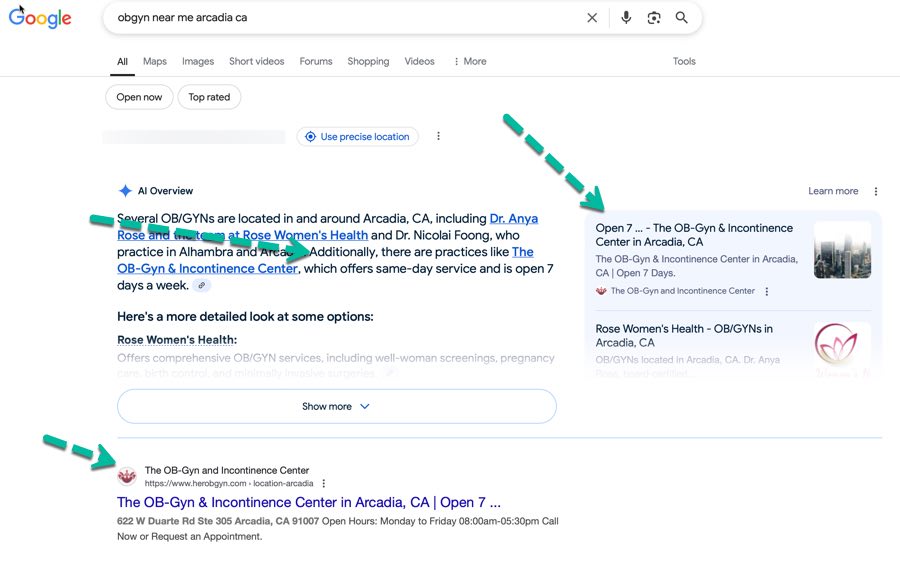OB/GYN Practice SEO Services Cost $799 to $999/mon
OB/GYN Practice SEO (Search Engine Optimization) refers to the strategic process of improving the online visibility of an obstetrics and gynecology practice, ensuring potential patients easily find the clinic when searching online. Effective medical SEO attracts new patients, enhances brand credibility, and positions the practice as a trusted women’s health resource in the community.
Example of a very good SEO results of a OB/GYN practice located in California.

What is the cost of OB/GYN Practice SEO?
The cost of OB/GYN practice SEO services generally ranges from $799 to $1999 per month. This cost can vary depending on the scope of services, the level of competition in the area, and the practice’s current SEO ranking. Some agencies also offer custom website design as part of their SEO packages, which can range from $5,000 to $10,000 one-time. However, if you consider GOLD or PLATINUM service from PatientGain, website, SEO and many other services are included.
Why is it important to have services pages for OB/GYN Practice SEO?
Having dedicated service pages is crucial for OB/GYN practice SEO because they allow you to target specific keywords related to the services you offer, improving your search engine ranking and attracting the right patients. Detailed service pages also build credibility and demonstrate expertise in a specific area, encouraging potential patients to choose your practice.

How long does it take for OB/GYN Practice SEO to work?
Answer: 4 Months to 1 Year (according to Google). However, there is no set or specific time for this question. It can take from a few weeks to several months before you will see any improvements. The true benefit of SEO is long term. According to Google SEO staff, medical marketing companies and agencies should set proper expectations for healthcare customers. It takes 4 months to 1 year to start seeing benefits of medical SEO and improvements in rankings. Watch this video from Google.
Examples of OB/GYN Practice SEO include:
- Website Optimization with Targeted Keywords:
- Using keywords like “best OB/GYN in Austin,” “prenatal care in Miami,” or “menopause treatment near me” strategically within website content, meta descriptions, page titles, and headings helps improve rankings on Google and other search engines.
- Local SEO and Google Business Profiles:
- Maintaining an updated Google Business Profile with accurate contact details, business hours, location, photos, and positive patient reviews. For example, optimizing for searches like “OB/GYN near Central Park” ensures higher visibility for location-specific queries.
- Educational Blog Posts and Patient Resources:
- Creating informative articles such as “5 Signs It’s Time to Visit Your OB/GYN,” “What to Expect During Your First Prenatal Visit,” or “Understanding PCOS Treatment Options” positions the practice as an authority, drives organic traffic, and answers common patient questions.
- Online Reputation Management:
- Encouraging satisfied patients to leave authentic, positive reviews on platforms like Google, Yelp, or Healthgrades. Actively responding professionally to feedback—both positive and negative—helps build trust and credibility among prospective patients.
- Mobile-Friendly Website:
- Ensuring the OB/GYN practice’s website loads quickly and displays properly on smartphones and tablets, since many patients search for providers using mobile devices, such as when searching for “emergency OB/GYN appointments near me.”
- Technical SEO and Page Speed:
- Optimizing website speed, security (SSL certificate), and structured data markup. For example, implementing schema markup for “Healthcare Provider” or “Medical Procedure” helps search engines clearly understand and display clinic information.
- Backlink Building and Collaborations:
- Gaining reputable backlinks by partnering with respected medical websites, local parenting blogs, or regional health organizations, such as publishing guest articles on a community parenting site about pregnancy health tips or common gynecological concerns.
How top OB/GYN SEO companies build the SEO of your OB/GYN website
1. Keyword Research:
- Example: Instead of just targeting the broad term “gynecologist,” a practice in Palo Alto might identify more specific and locally relevant keywords like:
- “gynecologist Palo Alto”
- “best OB/GYN near me in Palo Alto”
- “prenatal care Palo Alto CA”
- “high-risk pregnancy doctor Palo Alto”
- “minimally invasive gynecologic surgery Palo Alto”
- “IUD insertion Palo Alto”
- “menopause treatment Palo Alto”
- “annual pelvic exam Palo Alto”
2. On-Page Optimization:
- Example: Let’s say the practice offers prenatal care. To optimize the dedicated “Prenatal Care” page:
- Title Tag: Instead of a generic title like “Our Services,” they might use:
<title>Prenatal Care in Palo Alto, CA | [Practice Name]</title> - Meta Description: They’d write a compelling snippet that appears in search results, such as:
<meta name="description" content="Comprehensive prenatal care services in Palo Alto, CA at [Practice Name]. Experienced OB/GYNs providing personalized care throughout your pregnancy journey. Schedule your consultation today!"> - Headings: They’d use relevant H1, H2, and H3 tags to structure the content, incorporating keywords naturally:
<h1>Comprehensive Prenatal Care in Palo Alto</h1><h2>Our Approach to Prenatal Care</h2><h3>What to Expect During Your Prenatal Visits</h3>
- Content: The page would contain detailed, informative content about their prenatal services, including what’s involved in each trimester, available tests, support services, and the expertise of their doctors. They would naturally weave in keywords like “prenatal appointments,” “ultrasounds,” “genetic screening,” and “labor and delivery support.”
- Mobile-Friendliness: The website would be designed to adapt seamlessly to different screen sizes (desktops, tablets, smartphones) to provide a positive user experience on all devices.
- Page Speed: Images would be optimized, and the website’s code would be clean to ensure fast loading times, as slow websites can deter visitors and hurt rankings.
- Internal Linking: Links within the website would connect related pages, for example, linking from the “Prenatal Care” page to the “Meet Our Doctors” page or a blog post about “First Trimester Symptoms.”
- Title Tag: Instead of a generic title like “Our Services,” they might use:
3. Local SEO:
- Example:
- Google Business Profile (GBP): The practice would create or claim its GBP listing and ensure all information (name, address, phone number, website, hours of operation) is accurate and up-to-date. They would upload photos of their clinic, respond promptly to patient reviews (both positive and negative), and regularly post updates about their services or health tips. They might also utilize GBP features like appointment booking or Q&A.
- Local Citations: The practice would list its NAP information on relevant online directories like Yelp, Healthgrades, Vitals, Zocdoc, and local business directories specific to Palo Alto. Consistency in these listings is crucial.
- Localized Content: They might create blog posts like “Top 5 Things to Know About Choosing an OB/GYN in Palo Alto” or sponsor local community events and mention their involvement on their website.
4. Off-Page Optimization:
- Example:
- Link Building: The practice might reach out to local hospitals or parenting groups in Palo Alto to see if they would link to their website as a trusted resource. If a local news website publishes an article about women’s health and quotes one of their doctors, they would aim to get a backlink. High-quality backlinks from authoritative websites signal to search engines that the practice is a credible source.
- Online Reputation Management: They would actively monitor review sites like Google, Yelp, and Healthgrades for patient feedback. Responding professionally to reviews, even negative ones, shows they value patient opinions and are committed to providing good care. Positive reviews can significantly influence potential patients.
- Social Media Engagement: While not a direct ranking factor, the practice might use platforms like Facebook or Instagram to share informative content, answer patient questions, and build a community. This can increase brand awareness and drive traffic to their website.
5. Content Marketing:
- Example: The practice could create a blog section on their website and publish articles addressing common questions and concerns of their target audience, such as:
- “Understanding Your Menstrual Cycle”
- “What to Expect During Your First Prenatal Appointment”
- “Tips for Managing Morning Sickness”
- “The Benefits of Annual Well-Woman Exams”
- “Treatment Options for Endometriosis”
- They might also create short videos answering frequently asked questions or infographics explaining complex topics in an easy-to-understand format. This valuable content not only attracts potential patients searching for information but also establishes the doctors as experts.
6. Technical SEO:
- Example:
- Site Architecture: The website would have a clear and logical structure, making it easy for both users and search engine crawlers to navigate and understand the content.
- XML Sitemap: An XML sitemap would be submitted to search engines, listing all the important pages on the website to ensure they are properly indexed.
- robots.txt: This file would instruct search engine crawlers on which pages they can and cannot access.
- HTTPS: The website would use HTTPS to ensure secure communication between the user’s browser and the website server, which is a ranking factor for Google.
- Schema Markup: Implementing structured data markup (schema.org) can help search engines understand the content on the pages better, potentially leading to rich snippets in search results (e.g., displaying appointment booking options or star ratings).

